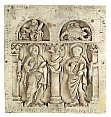Fragment of a reliquary

Signs of the zodiac might not be expected to feature on a box intended for the storage of relics. But two of these signs, namely a scales and a scorpion (the seventh and eighth sign of the zodiac) have been inserted above representations of the apostles on a small relic box from the second half of the 10th century which has traditionally been ascribed to the possession of the Empress Kunigunde. The ivory preserved in public museums of Berlin is - at a complete and regular design - is possibly one of six (6 x 2 signs and 6 x 2 apostles) and would have to be looked at as the fourth. But why do sings of the zodiac appear with representations of the apostles on a small box such as this? Early on in its development, the Christian Church had to explain itself to the pagan world and to examine pagan ideas such as the zodiac. The opinions of the Church Fathers differed. Clemens of Alexandria (around 200) cites the opinion of his his contemporary Theodotus that, after the birth of Christ, the 12 apostles took the place of the 12 signs of zodiac to determine destiny. Since the representation combines both apostles and signs of the zodiac, its seems that the notion of replacing one completely with the other has yet to be realised. However, it is notable that the zodiac signs are reduced in size and restricted to small spaces.




